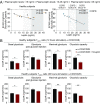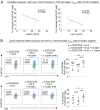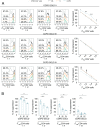An immunometabolic pathomechanism for chronic obstructive pulmonary disease
- PMID: 31308239
- PMCID: PMC6681742
- DOI: 10.1073/pnas.1906303116
An immunometabolic pathomechanism for chronic obstructive pulmonary disease
Abstract
Chronic obstructive pulmonary disease (COPD) is an inflammatory condition associated with abnormal immune responses, leading to airflow obstruction. Lungs of COPD subjects show accumulation of proinflammatory T helper (Th) 1 and Th17 cells resembling that of autoreactive immune responses. As regulatory T (Treg) cells play a central role in the control of autoimmune responses and their generation and function are controlled by the adipocytokine leptin, we herein investigated the association among systemic leptin overproduction, reduced engagement of glycolysis in T cells, and reduced peripheral frequency of Treg cells in different COPD stages. These phenomena were also associated with an impaired capacity to generate inducible Treg (iTreg) cells from conventional T (Tconv) cells. At the molecular level, we found that leptin inhibited the expression of forkhead-boxP3 (FoxP3) and its splicing variants containing the exon 2 (FoxP3-E2) that correlated inversely with inflammation and weakened lung function during COPD progression. Our data reveal that the immunometabolic pathomechanism leading to COPD progression is characterized by leptin overproduction, a decline in the expression of FoxP3 splicing forms, and an impairment in Treg cell generation and function. These results have potential implications for better understanding the autoimmune-like nature of COPD and the pathogenic events leading to lung damage.
Keywords: COPD; immunometabolism; leptin; regulatory T cells.
Copyright © 2019 the Author(s). Published by PNAS.
Conflict of interest statement
The authors declare no conflict of interest.
Figures









Similar articles
-
Dendritic cells and Th17/Treg ratio play critical roles in pathogenic process of chronic obstructive pulmonary disease.Biomed Pharmacother. 2018 Dec;108:1141-1151. doi: 10.1016/j.biopha.2018.09.113. Epub 2018 Oct 1. Biomed Pharmacother. 2018. PMID: 30372815
-
Restoring Th17/Treg balance via modulation of STAT3 and STAT5 activation contributes to the amelioration of chronic obstructive pulmonary disease by Bufei Yishen formula.J Ethnopharmacol. 2018 May 10;217:152-162. doi: 10.1016/j.jep.2018.02.023. Epub 2018 Feb 16. J Ethnopharmacol. 2018. PMID: 29454913
-
Assessment of Treg/Th17 axis role in immunopathogenesis of chronic injuries of mustard lung disease.J Recept Signal Transduct Res. 2016 Oct;36(5):531-41. doi: 10.3109/10799893.2016.1141953. Epub 2016 Feb 19. J Recept Signal Transduct Res. 2016. PMID: 26895417
-
Th17/Treg Imbalance in Chronic Obstructive Pulmonary Disease: Clinical and Experimental Evidence.Front Immunol. 2021 Dec 9;12:804919. doi: 10.3389/fimmu.2021.804919. eCollection 2021. Front Immunol. 2021. PMID: 34956243 Free PMC article. Review.
-
Revisiting regulatory T cells in type 1 diabetes.Curr Opin Endocrinol Diabetes Obes. 2012 Aug;19(4):271-8. doi: 10.1097/MED.0b013e328355a2d5. Curr Opin Endocrinol Diabetes Obes. 2012. PMID: 22732485 Review.
Cited by
-
Validation of a method evaluating T cell metabolic potential in compliance with ICH Q2 (R1).J Transl Med. 2021 Jan 6;19(1):21. doi: 10.1186/s12967-020-02672-7. J Transl Med. 2021. PMID: 33407568 Free PMC article.
-
Diagnostic Challenges and Pathogenetic Differences in Biomass-Smoke-Induced versus Tobacco-Smoke-Induced COPD: A Comparative Review.Diagnostics (Basel). 2024 Sep 27;14(19):2154. doi: 10.3390/diagnostics14192154. Diagnostics (Basel). 2024. PMID: 39410558 Free PMC article. Review.
-
The functions of CD4 T-helper lymphocytes in chronic obstructive pulmonary disease.Acta Biochim Biophys Sin (Shanghai). 2022 Jan 25;54(2):173-178. doi: 10.3724/abbs.2021009. Acta Biochim Biophys Sin (Shanghai). 2022. PMID: 35130627 Free PMC article. Review.
-
Identification of Metabolism-Associated Molecular Subtypes of Chronic Obstructive Pulmonary Disease.Int J Chron Obstruct Pulmon Dis. 2021 Aug 14;16:2351-2362. doi: 10.2147/COPD.S316304. eCollection 2021. Int J Chron Obstruct Pulmon Dis. 2021. PMID: 34429593 Free PMC article.
-
Regulatory T Cells in Pathological Cardiac Hypertrophy: Mechanisms and Therapeutic Potential.Cardiovasc Drugs Ther. 2024 Oct;38(5):999-1015. doi: 10.1007/s10557-023-07463-y. Epub 2023 May 15. Cardiovasc Drugs Ther. 2024. PMID: 37184744 Review.
References
-
- Barnes P. J., et al. , Chronic obstructive pulmonary disease. Nat. Rev. Dis. Primers 1, 15076 (2015). - PubMed
-
- Cosio M. G., Saetta M., Agusti A., Immunologic aspects of chronic obstructive pulmonary disease. N. Engl. J. Med. 360, 2445–2454 (2009). - PubMed
-
- Rahman I., Adcock I. M., Oxidative stress and redox regulation of lung inflammation in COPD. Eur. Respir. J. 28, 219–242 (2006). - PubMed
Publication types
MeSH terms
Substances
Grants and funding
LinkOut - more resources
Full Text Sources
Medical
Research Materials
Miscellaneous

